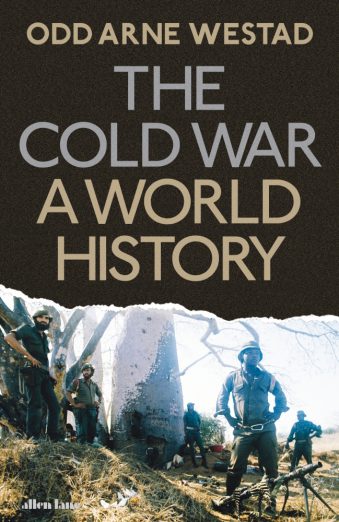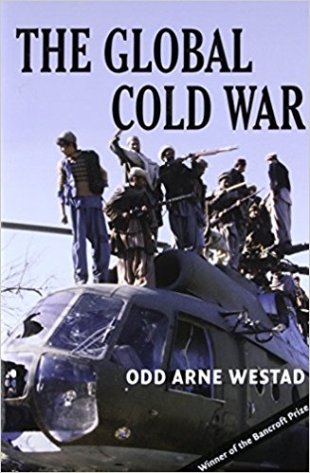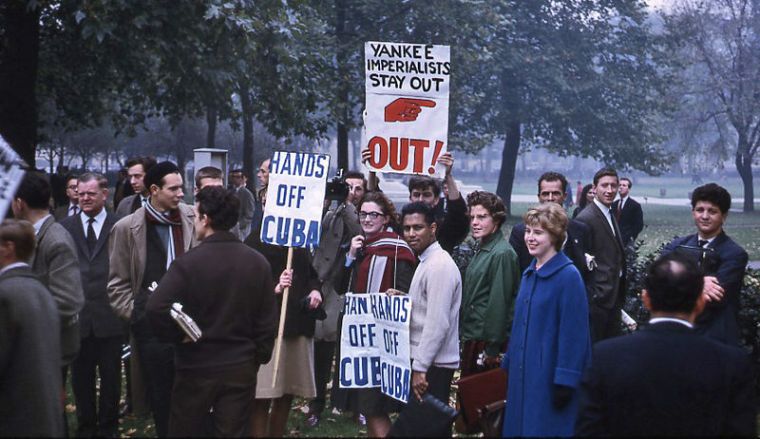By John Munro
St. Mary’s University [1]
First published by the Imperial & Global Forum on February 14, 2018.
The gap between the Cold War’s history and its new historiography spanned only about a decade and a half. The Cold War concluded during the George H.W. Bush presidency, but for the field we now call “the US and the world,” the Cold War paradigm reached its terminus, if we have to be specific, in 2005. That year saw the publication of two books that together marked a milestone in how scholars would write about the Cold War. John Lewis Gaddis’ The Cold War: A New History told its story through engaging prose and a top-down approach that gave pride of place to Washington and Moscow as the centers of a bifurcated world. For its part, Odd Arne Westad’s The Global Cold War: Third World Interventions and the Making of Our Times offered a triangular model in which empires of liberty and of justice interacted with Third World revolutionaries who led campaigns for decolonization that shifted into high gear after World War II. Gaddis’ survey represented a culmination of the traditional two-camps schema which tended to reflect self-understandings of the US government but which, after Westad’s concurrent synthesis, could no longer stand without qualification, without reference to the colonial dimension of the Cold War itself. In this sense, 2005 was a before-and-after historiographical event.
The classic Cold War concept, in which the governing and formal decolonization of Western Europe’s empires was one thing, and the rivalry between the superpowers something altogether else, has become diminished, but not because of one book alone. Various social movements have rejected the tenets of the Cold War at different times, and as far back as 1972, historians Joyce and Gabriel Kolko argued that “The so-called Cold War…was far less the confrontation of the United States with Russia than America’s expansion into the entire world.”[2] In 2000, Matthew Connelly called attention to the distortions accompanying attempts to have postwar history fitted to the constraints of the Cold War paradigm. The “Cold War lens,” as Connelly memorably called it, had obscured racial and religious realities. As more scholars began to push the weight of culture, decolonization, gender, public opinion, and more against the Cold War paradigm’s once stable conceptual walls, the foundations faltered. And since Westad’s 2005 landmark, a notable tendency has developed across the disciplines in which scholars – notably Mark Philip Bradley, Jodi Kim, Heonik Kwon, and the authors (including Westad) contributing to Joel Isaac and Duncan Bell’s volume on the Cold War idea – have further troubled the notion that what followed World War II is best understood by focusing on how the leaders of the US and USSR saw the world.[3]
It’s also worth noting that the recent literature’s rough division between works that sit more comfortably within the Cold War  paradigm and those that prompt a rethinking of its foundations does not map neatly onto the difference between local and globally-oriented studies. Melvin Leffler’s 2008 transnational history of US-Soviet relations and Samuel Zipp’s New-York focused book on urban renewal of 2010 both fit within Cold War studies, for example, while Masuda Hajimu’s global reinterpretation of the Korean War and Yulia Komska’s cultural genealogy of the West German-Czech borderlands (both published in 2015) render suspect what we thought we knew about the Cold War.[4] All four books are excellent, and it would be unhelpful to make a “without paradigm good, within paradigm bad” argument across wide swaths of insightful scholarship. The point is, rather, to note that The Cold War: A World History arrives at what Federico Romero calls a historiographical crossroads, on a conceptual terrain conspicuously remapped since the publication of The Global Cold War.
paradigm and those that prompt a rethinking of its foundations does not map neatly onto the difference between local and globally-oriented studies. Melvin Leffler’s 2008 transnational history of US-Soviet relations and Samuel Zipp’s New-York focused book on urban renewal of 2010 both fit within Cold War studies, for example, while Masuda Hajimu’s global reinterpretation of the Korean War and Yulia Komska’s cultural genealogy of the West German-Czech borderlands (both published in 2015) render suspect what we thought we knew about the Cold War.[4] All four books are excellent, and it would be unhelpful to make a “without paradigm good, within paradigm bad” argument across wide swaths of insightful scholarship. The point is, rather, to note that The Cold War: A World History arrives at what Federico Romero calls a historiographical crossroads, on a conceptual terrain conspicuously remapped since the publication of The Global Cold War.
As astute reviewers of this new book have already noted, there’s much to admire in Westad’s World History. It’s difficult to think of a more capable and knowledgeable guide to this nearly-overwhelming topic than its author, and the book’s promise is delivered in full. Organization must have been a challenge for a book that knows so much, but the chapter headings strike just the right balance between telegraphing what’s coming and revealing the not-completely-expected around various corners, as when an analysis of mid-sixties coups in Congo and Indonesia shows up amid a discussion of the US war against Vietnam, or Tito’s Yugoslavia appears amid Nehru’s India, or Bandung amid Suez. Then there’s the sources. The library of secondary sources that A World History must certainly have been based on remains offstage, beyond covers of the book, meaning that readers are presented with a curated set – the final authority within which, as readers will find on page 675, provides a synth-pop surprise – of footnoted primary sources to consult and consider. Within the body of the text, these sources leave a trail of anecdotes at turns entertaining and instructive, and as readers of Westad’s history of China and the world might expect, he shares a small sampling of personal reminiscences along the way that only add to the narrative.
Crucially for a work that seeks to take a complex subject off campus, A World History features a steady stream of interpretive insights and lively, often economical, prose. Among the insights, the account of the Cold War’s end as the decomposition of a diplomatic structure rather than an all-of-a-sudden event marks a particular advance in our understanding, and should hopefully put to rest simplistic theories of Ronald Reagan’s single-handed victory over the USSR. The final chapters show how shifts in the global economy, in technology, in environmental awareness, in ideas about identity, and in the ascendancy of rights discourses, all of which have roots traceable to at least the 1970s, wound down the superpower contest more than any presidential policy. In terms of writing, between European and US teenagers “more united by Brando than NATO” in the 1950s, Indian Five Year Plans that were “more Lenin than Laski,” and a state of affairs originating in the 1980s in which “neoconservative politics upheld neoliberal economics, and vice versa,” World History’s style is another of its strengths. This is all the more so because Westad not only explains various episodes clearly but also maintains a brisk pacing that never lingers too long on a given topic. No one could possibly read this book and not learn something, probably many things, new. Did you know that Algerian President Ahmed Ben Bella was overthrown in 1965 by forces who posed as extras during the filming of Gillo Pontecorvo’s Battle of Algiers?
If the main distinction between Westad’s Global and World histories is that between scholarly breakthrough and wide-audience overview, both books should be counted as equally successful. But both also exist in relation to academic literatures, and their relationship to imperial history constitutes a notable difference between the two volumes. The Global Cold War kicked open the doorway between an older binary model and one in which “the Cold War was a continuation of colonialism through slightly different means.” A World History takes a more ambiguous stance toward the question of empire. Even the table of contents suggests the change: in the earlier book, anticolonialists of the global South are the subject of the third chapter, the first two dedicated respectively to the empires of the US and USSR. In the new book, global decolonization does not come fully into focus until chapter 10.
 This is not to say that imperial history is relegated to the side lines of Westad’s new Cold War story. In the introduction, we are told – in an echo from The Global Cold War – that both the communist and capitalist conceptions of modernity grew out of European expansion. A World History also points out that for “Third World leaders the Cold War was an outgrowth of the colonial system,” and that from this perspective, the “Cold War was against the interests of the Third World.” Speaking more directly in his own voice, Westad opens a chapter on the Middle East with the following sentence: “As everywhere else in Asia and Africa, the Cold War in the Middle East must be understood as part of a long-term struggle between colonialism and its opponents.” The Cold War, then, was colonialism. But in multiple other places in the book, the Cold War is presented as something other than imperial. “Postwar US Administrations,” for instance, “mostly failed to prioritize anticolonialism over Cold War concerns.” In Algeria, “the Cold War priorities of the United States had little time for France’s last colonial war,” while in Vietnam, the postwar conflict “started as a revolt against colonial oppression and ended as a set of wars deeply enmeshed with the global Cold War.” The Cold War, here, was distinct from colonialism. If The Global Cold War marked an imperial turn within Cold War studies, A World History seems to take a step back. Just when Cold War studies appears poised to productively merge into the fold of imperial studies, Westad’s authoritative new synthesis stops short of telling the story of the Cold War as one of colonialism’s chapters.
This is not to say that imperial history is relegated to the side lines of Westad’s new Cold War story. In the introduction, we are told – in an echo from The Global Cold War – that both the communist and capitalist conceptions of modernity grew out of European expansion. A World History also points out that for “Third World leaders the Cold War was an outgrowth of the colonial system,” and that from this perspective, the “Cold War was against the interests of the Third World.” Speaking more directly in his own voice, Westad opens a chapter on the Middle East with the following sentence: “As everywhere else in Asia and Africa, the Cold War in the Middle East must be understood as part of a long-term struggle between colonialism and its opponents.” The Cold War, then, was colonialism. But in multiple other places in the book, the Cold War is presented as something other than imperial. “Postwar US Administrations,” for instance, “mostly failed to prioritize anticolonialism over Cold War concerns.” In Algeria, “the Cold War priorities of the United States had little time for France’s last colonial war,” while in Vietnam, the postwar conflict “started as a revolt against colonial oppression and ended as a set of wars deeply enmeshed with the global Cold War.” The Cold War, here, was distinct from colonialism. If The Global Cold War marked an imperial turn within Cold War studies, A World History seems to take a step back. Just when Cold War studies appears poised to productively merge into the fold of imperial studies, Westad’s authoritative new synthesis stops short of telling the story of the Cold War as one of colonialism’s chapters.
And it is in this very tension between the Cold War and the imperial, one left unresolved in this new and very worthwhile book, that speaks most directly to what remains at stake in the study of the Cold War. For Cold War studies, World History indicates that the field is in a period of flux, its future uncertain. Whether the study of the Cold War will be reinvigorated by a greater engagement with colonial studies or instead become overwhelmed by it remains to be seen. Meanwhile, Cold War and colonial themes, as everyone knows, animate contemporary political debate. Influential arguments hailing from within the classic paradigm assume the Cold War while redeploying its ideological tools in service of the political status quo. A World History gives such arguments precious little oxygen, but as more writers present the Cold War as colonial history, the tenets of old style anticommunism will seem all the less tenable.
A World History takes us some of the way toward a deeper interaction between Cold War and colonial studies, but there is farther to go and more to be gained by venturing a greater distance in this direction. For example, bringing these fields into greater conversation could further enhance insights about race, gender, and culture that have already done so much to transform the study of the Cold War. It could also help make sense of US politics that connect to larger continuities but seem since 2016 to have cast aside assumptions subscribed to by both main parties since the late-1940s. It could potentially bring greater comparative clarity to the public discussion about whether rigor or apologia is the better way to approach the topic of imperialism. It could further enliven analyses of the Cold War with revelatory retheorizations and promising lines of historical inquiry from new perspectives on decolonization, non-alignment, and the Fourth World. It could make more apparent how the colonial policies of incarceration grew out of Cold War narratives of security and the criminalization of dissent. It could more fully demonstrate, as Timothy Nunan puts it, how “Cold War entanglements reflected bigger debates abut Third World sovereignty.”
Such an interaction could see Cold War studies become a subfield of colonial studies.[6] And why not? “It is quite possible,” World History’s introduction notes, “that the Cold War will be reduced in significance by future historians.” That process, one which Westad himself has played a decisive role in propelling, is already discernible in the historiography, especially in relation to the history of imperialism. But before saying good bye to all that has comprised the Cold War paradigm, we needed a full account, a last word, that summed it all up, something like what John Lewis Gaddis did in 2005. World History has given us that. So let’s read it and learn from it as we witness the event that is a shift between paradigms.
[1] Thank you to Radhika Natarajan and Padraig Riley for sharing their very invaluable insights with me on the relationships between empire and the Cold War.
[2] Joyce and Gabriel Kolko, The Limits of Power, The World and United States Foreign Policy, 1945-1954 (New York: Harper & Row, 1972), 31.
[3] Mark Philip Bradley, “Decolonization, the global South, and the Cold War, 1919-1962,” in The Cambridge History of the Cold War, Volume I: Origins, Eds. Melvyn P. Leffler and Odd Arne Westad (New York: Cambridge University Press, 2010), 464-485; Jodi Kim, Ends of Empire: Asian American Critique and the Cold War (Minneapolis: University of Minnesota Press, 2010); Heonik Kwon, The Other Cold War (New York: Columbia University Press, 2010); Joel Isaac and Duncan Bell, Eds., Uncertain Empire: American History and the Idea of the Cold War (New York: Oxford University Press, 2012). Although its argument is not explicitly concerned with reframing the Cold War idea, Vijay Prashad’s essential The Darker Nations: A People’s History of the Third World (New York: New Press, 2007) demonstrates how decolonization in the twentieth century can be narrated without reliance upon a Cold War framing.
[4] Melvyn P. Leffler, For the Soul of Mankind: The United States, the Soviet Union, and the Cold War (New York: Farrar, Strauss, and Giroux, 2007); Samuel Zipp, Manhattan Projects: The Rise and Fall of Urban Renewal in Cold War New York (New York: Oxford University Press, 2010); Masuda Hajimu, Cold War Crucible: The Korean Conflict and the Postwar World (Cambridge, MA: Harvard University Press, 2015); Yulia Komska, The Icon Curtain: The Cold War’s Quiet Border (Chicago: University of Chicago Press, 2015).
[5] For the Soviet side, see, for example, the argument that “Stalin’s design for ‘socialism in one country’ became in reality colonialism in one country” in Kate Brown’s brilliant A Biography of No Place: From Ethnic Borderland to Soviet Heartland(Princeton: Princeton University Press, 2003), 115, and a discussion of some of the more recent literature in Moritz Florin, “Beyond Colonialism? Agency, Power, and the Making of Soviet Central Asia,” Kritika 18, no. 4 (Fall 2017): 872-838. For US empire, the starting point remains Paul A. Kramer’s superb summation of the literature, from which I borrow some of my title here: “Power and Connection: Imperial Histories of the United States and the World,” American Historical Review 116, no. 5 (December 2011): 1348-1391.
[6] Though not a work about the Cold War per se, the ways that the Cold War as a subject is folded into a larger history of US empire in the essays of Nikhil Singh’s Race and America’s Long War (Berkeley: University of California Press, 2017) make that book an exemplary model of the kind of approach I’m thinking of here.
You may also like:
Undergraduate Essay Contest Honorable Mention: The Global Cold War by Odd Arne Westad (2007)
Ideological Origins of a Cold Warrior: John Foster Dulles and his Grandfather
Cold War Crucible: The Korean Conflict and the Postwar World, by Hajimu Masuda (2015)




